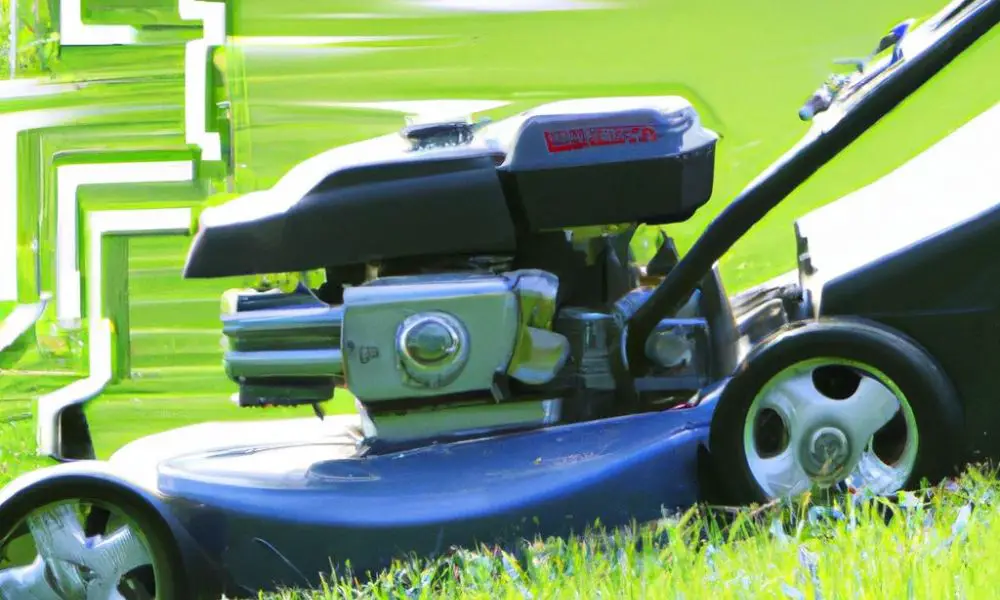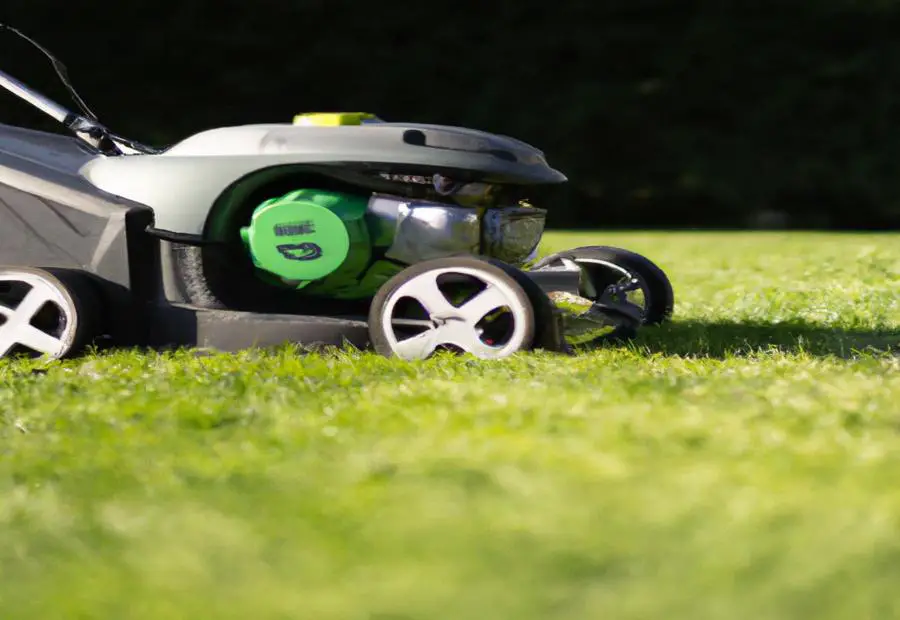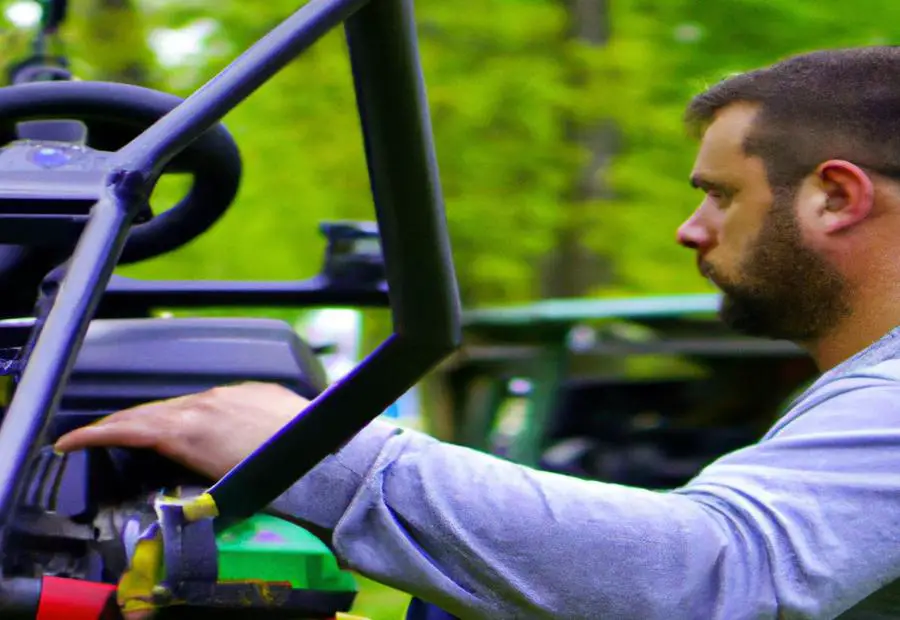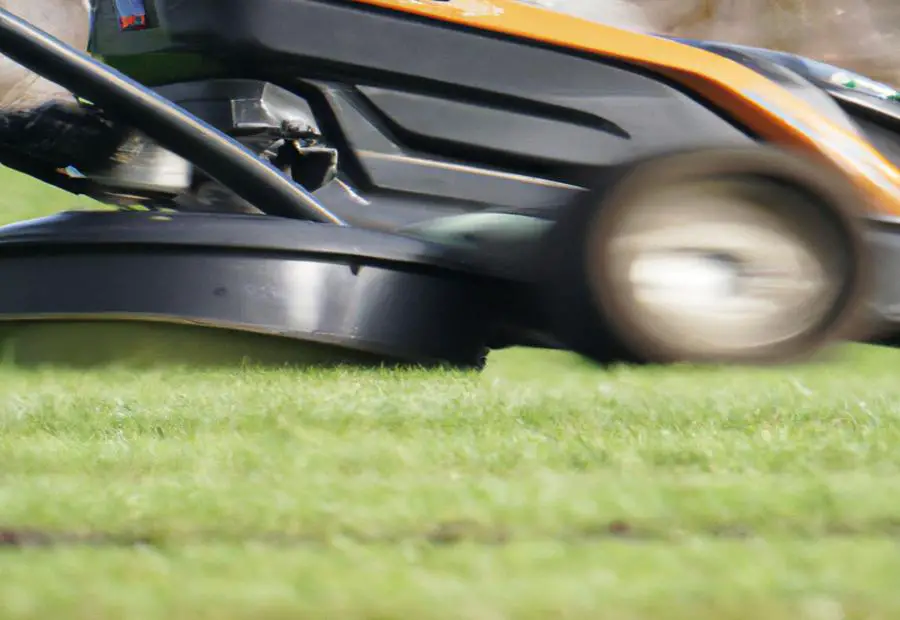GardenerHeaven.com is reader-supported. When you buy through links on our site, we may earn an affiliate commission.

If you’ve ever faced the frustration of your hydrostatic mower struggling to go uphill, you’re not alone. This section will investigate the common issue of hydrostatic mowers having trouble navigating inclines. We’ll also highlight the importance of troubleshooting and provide valuable tips and solutions to tackle this uphill battle. Get ready to conquer those hills confidently and keep your lawn pristine.
Explanation of the issue: Hydrostatic mower struggling to go uphill

Photo Credits: Gardenerheaven.Com by Joe White
Hydrostatic mowers that struggle to go uphill are a common issue. Factors include insufficient drive belt traction, hydro air-lock in the transmission, and lack of hydrostatic oil. Clean the drive belt area and check the belt tension to fix this. Replace the belt if needed. An air-lock in the hydrostatic transmission? Purge the air from the system. Insufficient hydrostatic oil? Top off the oil level. It is essential to address these issues quickly. Regular maintenance and following tips for optimal performance can help, too.
Troubleshooting: Make fixing your mower less stressful than rolling it downhill.
Importance of troubleshooting
Troubleshooting a hydrostatic mower’s uphill struggle is essential. It helps identify and resolve any issues that could prevent optimal performance.
A lack of traction from the drive belt is one reason a mower may not climb hills. Dirt or debris in the belt area, loose tension, and a damaged belt or idler spring all contribute. Cleaning the area, checking and adjusting the tension, and replacing faulty parts can improve the mower’s performance.
An air-lock in the transmission can also disrupt a mower’s uphill journey. Purging the air from the system can get things going again.
Insufficient hydrostatic oil levels are another problem. This can be due to leaks or poor maintenance. Topping off the oil level ensures enough lubrication for smooth operation.
Troubleshooting is key to improving a mower’s uphill capabilities. Follow regular maintenance procedures to ensure consistent functionality.
One landscaper experienced this firsthand. Their hydrostatic mower was struggling to go uphill. After troubleshooting, they found the drive belt had worn out due to incorrect tensioning. Replacing the belt and adjusting the tension solved the problem.
Troubleshooting is necessary to help a hydrostatic mower tackle the incline.
Reasons why a hydrostatic mower won’t go up hills
When it comes to a hydrostatic mower not going up hills, several reasons could be causing this issue. In this section, we will discuss some common factors that might be contributing to the problem. From insufficient drive belt traction to a hydro-air-lock in the transmission, we will explore these potential causes and provide troubleshooting tips and solutions to help you overcome the challenge.
Insufficient drive belt traction
Lack of traction in the drive belt area? Many things could cause it. Cleaning it is vital for troubleshooting. Check belt tension and replace it if needed – this can help with insufficient drive belt traction. Also, replacing the idler spring if worn or damaged could be necessary. These solutions can help to get drive belt traction back to normal – so you can mow uphill without any hiccups!
Causes of lack of traction
Several factors can cause a lack of traction in a hydrostatic mower when going uphill. Debris or buildup in the drive belt area can interfere with the belt’s functioning, reducing traction. Improper tension in the belt or a worn-out idler spring can also contribute. Slippage in the drive system prevents efficient movement. Air-lock in the hydrostatic transmission can also cause a lack of traction. This is due to low hydraulic fluid levels, leaks, or improper maintenance. Insufficient hydrostatic oil levels can also result in a lack of traction.
Following a step-by-step troubleshooting process is important to resolve these issues and improve traction. Here are the steps:
- Clean the drive belt area and check belt tension. Replace if necessary.
- Purge air from the hydrostatic transmission and top off hydrostatic oil levels.
For optimal performance when mowing uphill, regular maintenance is key. Follow manufacturer guidelines for recommended service intervals and procedures. Clean, check, or replace the drive belt and idler spring to conquer those hills with your hydrostatic mower!
Solutions: Cleaning the drive belt area, checking belt tension, replacing the belt or idler spring
Are you having difficulty getting a hydrostatic mower up a hill? It could be because of multiple causes. Three steps can be taken to fix this: clean the drive belt area, check belt tension, and replace the belt or an idler spring. This will help it handle inclines better.
- Clean the belt area: Get rid of any dirt and debris that may have built up near the drive belt. This helps it work properly and stops it from getting blocked on hills.
- Check the tension: Put your finger on the drive belt and apply moderate pressure. It should be slightly flexible, not too tight or too loose. If it is loose, adjust it as instructed by the manufacturer. If it’s worn or damaged, replace it.
- Change the spring or belt: The idler spring helps the belt distribute power for hills and flat surfaces. If it’s worn or broken, replace it immediately. This will help the mower appropriately run and avoid further issues.
To make the mower run better on hills, keep it clean, check the tire pressure, and lubricate its moving parts. This will help it tackle inclines with no trouble.
Hydro air-lock in the transmission
- Look for any obstructions or debris in the system.
- Double-check that all connections and hoses are tight and not leaking.
- Start on a level surface and let the mower warm up.
- Follow manufacturer instructions to purge air from the transmission. It may involve engaging and disengaging the drive system many times.
Uncovered yet is the damage that may happen if air remains trapped in the system for a long time. This leads to decreased performance and maybe even failure of the transmission parts.
A true story about a hydro air-lock in the transmission is when a user had trouble mowing uphill. After troubleshooting steps and removing any trapped air, they managed to get their mower back to normal, and it could mow uphill without issues.
Causes of air-lock
The air-lock in a mower’s hydrostatic transmission can cause it to struggle on hills. This is when air gets trapped in the system, which stops hydraulic fluid flowing and affects performance.
A leak or crack in the transmission lines can let air in. Not doing regular maintenance, like changing the oil or mowing on uneven ground or at high speed, can also cause air-lock.
To fix this, purge the air. The manufacturer’s manual should tell you how. Usually, this means running the mower for a bit with the drive control on and off multiple times. This releases the air and brings back proper hydraulic function.
To avoid air-lock in the future, maintain the mower’s hydrostatic transmission. Check for any leaks or cracks and repair them. Also, change the oil as the manufacturer says.
You can ensure the mower performs well going uphill by tackling any air-lock issues. Neglecting this can lead to problems and damage other parts. Keep up with maintenance and troubleshooting for smooth mowing on uneven terrain.
Solution: Purging air from the hydrostatic transmission
A hydrostatic transmission in a mower can face an air-locking issue, which affects performance when going uphill. To prevent further damage, this issue must be addressed promptly.
A four-step guide can help purge the air from the hydrostatic transmission:
- Find the air purge valve near the fluid reservoir or on top of the transmission housing.
- Turn off the engine and engage the parking brake.
- Use a wrench or pliers to open the valve slowly, allowing any trapped air to escape.
- Monitor the fluid level in the reservoir. Release air from the purge valve until only a steady stream of fluid is emitted without any air bubbles.
Optimal performance uphill requires regular maintenance of your hydrostatic mower. Check and top off fluid levels, and inspect for any leaks or wear on drive belts. This can help prevent air-lock and ensure a smooth operation on inclines. Oil depletion may hinder your mower’s uphill ambitions.
Lack of hydrostatic oil
Insufficient hydrostatic oil? You may have a problem! It can lead to decreased performance and loss of power. Maintaining the right hydrostatic oil level is essential to keep the mower functioning correctly.
Low oil = friction and overheating in the transmission. This reduces efficiency and output. You are making it difficult for the mower to go uphill. Plus, it can lead to increased wear and tear.
Check and top off the hydrostatic oil level. Look for leaks or signs of depletion. If you spot any, top off the reservoir with the recommended fluid.
Regular maintenance and monitoring of the hydrostatic system will help ensure optimal performance. Prevent issues like lack of oil, and help the mower handle hilly terrain!
Causes of oil depletion
Various factors can cause hydrostatic oil depletion in a mower. A leak in the system, damaged seal, or loose connection can lead to gradual oil loss. Improper maintenance, such as not regularly checking and topping off the oil level, can also be the culprit. Extreme temperatures and harsh conditions can contribute, too.
Maintain the hydrostatic mower for optimal performance:
- Inspect the system for leaks and address any issues right away;
- Check and top off the oil level regularly.
High-quality oil recommended by the manufacturer can help prevent oil depletion.
Neglecting proper maintenance and depleting oil levels can cause severe issues in the mower’s performance. It may struggle to go uphill due to insufficient lubrication and suffer premature wear and component damage.
To ensure optimal performance and longevity of a hydrostatic mower, stay vigilant about maintaining proper oil levels. Top off your hydrostatic oil level for smooth sailing uphill!
Solution: Topping off the hydrostatic oil level
It’s crucial to keep the hydrostatic oil level in your mower topped off for proper functioning, especially when tackling hills. Here’s a step-by-step guide on how to do this:
- Find the fill plug or dipstick on the hydrostatic transmission.
- Please take out the fill plug or dipstick and wipe it clean.
- Pour the recommended type of hydraulic oil for your mower model into the transmission.
- Add small amounts of oil and check the fluid level with the dipstick or fill hole.
- Keep adding oil until it reaches the recommended level.
- Securely replace and tighten the fill plug or dipstick.
This will guarantee your hydrostatic mower has enough hydraulic oil for smooth operation. It’s essential to top off the hydrostatic oil level as part of regular maintenance.
Other troubleshooting tips should also be considered. These include cleaning the drive belt area, checking belt tension, and purging air from the transmission.
Regular maintenance and attention to these troubleshooting tips will improve your mower’s performance and extend its lifespan. Ensure your hydrostatic mower is adequately maintained, and easily conquer those uphill challenges!
Step-by-step troubleshooting tips

Photo Credits: Gardenerheaven.Com by Bryan Robinson
Discover the step-by-step troubleshooting tips that can help you resolve issues with your hydrostatic mower. From cleaning the drive belt area to purging air from the hydrostatic transmission, we will guide you through each necessary step. Additionally, we will discuss checking belt tension and topping off the hydrostatic oil level for optimal mower performance. Say goodbye to your mower’s uphill woes with these practical solutions.
Step 1: Cleaning the drive belt area
It would be best to clean the drive belt area to keep your hydrostatic mower’s traction. Cleaning helps the belt engage better and move the mower up hills. Here’s how to do it:
- Check the belt for cracks, fraying, or slackness. If there are issues, replace it.
- Remove dirt, grass clippings, or other debris around the drive belt.
- Clean pulleys and tensioners with a cloth or brush. Make sure nothing’s blocking them.
- Put a bit of lubricant on the pulleys and tensioners. Please don’t use too much, as it will attract dirt.
Regularly cleaning the drive belt area is essential. Do it after every few mowing sessions or when performance drops.
Step 2: Checking belt tension and replacing if necessary
Troubleshooting a hydrostatic mower that struggles to climb hills? Check the belt tension and replace it if it’s needed. The drive belt is key to giving traction to the mower. If it’s loose or worn, it won’t climb hills well.
To check and replace:
- Locate the drive belt area on your mower.
- Check for visible wear, cracks, or fraying.
- Push in the center with moderate force. Excessive slack or tightness means adjustment may be needed.
- Read your mower manual for adjusting belt tension. This might involve adjusting pulleys or tightening bolts.
- If the belt’s damaged, replace it. Your manual will show how to remove and install a new one.
- Test the mower on an incline after making adjustments or replacements.
Checking and replacing the belt tension can fix any issues with inadequate traction caused by a faulty drive belt. Each mower model may have different procedures, so check the manual.
Regular maintenance can help prevent belt tension issues and keep your hydrostatic mower running well on hills and uneven terrain. Keep an eye on all belts and make adjustments or replacements as needed. Now, go climb those hills!
Step 3: Purging air from the hydrostatic transmission
Purging air from a hydrostatic transmission is necessary for a mower struggling to climb hills. Air-lock within the transmission can cause loss of power and make it hard for the mower to get up inclines. To purge air, these steps should be taken:
- Find the purge valve or plug on the transmission near the top or side.
- Put a container or pan beneath the purge valve to catch any oil released.
- Open the valve or plug slowly. A hissing sound may be heard as air escapes.
Each mower model has different purging instructions, so consult the owner’s manual. Purging air from the hydrostatic transmission gives full power and efficiency back, making inclines much easier. In short, purging air from the hydrostatic transmission is essential when troubleshooting a mower trying to go uphill. It brings back optimal power and efficiency, enabling successful mowing on inclines.
Step 4: Topping off the hydrostatic oil level
- The fourth step in troubleshooting a hydrostatic mower that struggles to go uphill is topping off the hydrostatic oil level. To do so, these three steps should be followed:
- Find the hydrostatic oil reservoir. It is usually near the transmission or on the side of the engine.
- Take out the cap or plug and check the oil level. If it is low, add hydraulic fluid.
- Put new hydraulic fluid into the reservoir until it reaches the recommended level shown by a dipstick or fill line.
- Enough lubrication and hydraulic pressure are provided by topping off the hydrostatic oil level. This allows for smoother operation and enough power when going uphill.
- It is important to maintain an optimal hydrostatic oil level. This prevents damage to the transmission and ensures proper functioning of the mower. Checking and topping off the oil regularly extends the lifespan of the equipment and improves its performance on hills.
Improving the performance of a hydrostatic mower going uphill

Photo Credits: Gardenerheaven.Com by Samuel Green
Regular maintenance and following some crucial tips are essential to optimize the performance of your hydrostatic mower when going uphill. Neglecting regular maintenance can lead to decreased efficiency and potential issues. By implementing these tips, you can ensure your hydrostatic mower operates smoothly on inclines, allowing it to tackle challenging terrains easily. Stay tuned to discover the importance of regular maintenance and valuable tips for achieving optimal performance.
Importance of regular maintenance
Regular maintenance is critical for the optimal performance of a hydrostatic mower. Taking care of it regularly ensures all components are in good condition and can tackle inclines. Neglecting maintenance can lead to issues, such as inadequate drive belt traction, hydro air-lock in the transmission, and low levels of hydrostatic oil.
Clean the drive belt area often to remove obstructions that may inhibit traction. Check belt tension and replace worn or loose belts for effective power transfer. Purge air from the hydrostatic transmission to maintain smooth operation. Fill up hydrostatic oil to prevent potential damage due to low levels.
Regular maintenance also helps when mowing uphill. It ensures all components are operating correctly and lowers the risk of breakdowns. Following manufacturer guidelines and regular upkeep enhances the mower’s longevity and reliability.
In conclusion, regular maintenance is essential for a hydrostatic mower to handle inclines. Cleaning, inspecting, purging, and topping off fluid levels improves performance and prevents unexpected problems. Proactive maintenance brings smoother operation and successful mowing sessions.
Tips for optimal performance
Here are some essential points to optimize a hydrostatic mower’s performance when going uphill. Following them should make mowing on hills more accessible and more efficient.
- Carry out regular maintenance of the hydrostatic mower as recommended by the manufacturer.
- Check tire pressure regularly for better grip on uneven surfaces.
- Adjust the cutting height to reduce strain on the transmission.
- Avoid overloading the mower deck with grass clippings or debris.
- Maintain a steady pace when mowing uphill and avoid abrupt changes in speed or direction.
- Opt for a mower model with higher horsepower and torque specifically designed for hilly terrains.
Every hydrostatic mower may have specific features or requirements, so looking at the manufacturer’s manual is wise.
Heed these tips for optimal performance; you’ll get the most out of your hydrostatic mower on hills. Good maintenance is key to getting the best out of it and prolonging its lifespan. If possible, stairs may be a better option than hills.
Conclusion

Photo Credits: Gardenerheaven.Com by Scott Gonzalez
In conclusion, let’s recap the troubleshooting tips for a hydrostatic mower that won’t go up hills and emphasize the significance of regular maintenance for uphill mowing.
Recap of troubleshooting tips
Troubleshooting a hydrostatic mower that has difficulty going up hills? Here are the tips:
- Remove dirt and debris from the drive belt area and check belt tension. Replace the belt or idler spring if needed.
- Purge air from the hydrostatic transmission system as per manufacturer instructions.
- Make sure the hydrostatic oil level is topped off.
By doing these steps, you can fix the issue!
Final remarks on the importance of maintaining a hydrostatic mower for uphill mowing
Maintaining a hydrostatic mower is essential for optimum performance on hills. Neglecting this can lead to issues such as insufficient drive belt traction, hydro air-lock in the transmission, and lack of hydrostatic oil. All these can affect the mower’s capacity to handle slopes.
To address insufficient drive belt traction, cleaning the drive belt area and checking the tension is essential. This will improve grip and performance on hills. Replacing the belt or idler spring may be needed, too.
Air trapped in the hydrostatic transmission can impede power transfer and prevent efficient uphill mowing. To eliminate this problem, purging air from the system is necessary.
Ensuring adequate oil levels is essential for the smooth operation of the hydrostatic system. Regularly checking and topping off these oil levels means the mower will have enough lubrication and hydraulic pressure for hills.
To summarise, the maintenance of a hydrostatic mower is key for successful uphill mowing. Address issues such as insufficient drive belt traction, hydro air-lock in the transmission, and lack of hydrostatic oil. Regular maintenance will enhance your mower’s ability to navigate inclines and achieve the best results.
Some Facts About Hydrostatic Mower Won’t Go Up Hills? Troubleshooting Tips and Solutions:
- ✅ Hydrostatic mowers may struggle to go uphill due to insufficient drive belt traction, hydro air-lock, or lack of hydro oil. (Source: Team Research)
- ✅ Lack of traction on the drive belt can be caused by dirt and grass build-up in the pulleys, as well as a worn or slack belt. (Source: Team Research)
- ✅ Hydrostatic transmission with an air-lock occurs when air or oil cavitation prevents the movement of the oil, leading to a loss of force. (Source: Team Research)
- ✅ A lack of hydrostatic oil in the system can result in reduced power output of the wheels, causing slowness or an inability to go uphill. (Source: Team Research)
- ✅ Proper maintenance of a hydrostatic drive is essential for optimal performance. (Source: Team Research)
FAQs about Hydrostatic Mower Won’T Go Up Hills? Troubleshooting Tips And Solutions
Why is my hydrostatic mower having a tough time going uphill?
Your hydrostatic mower may struggle to go uphill due to various reasons, such as insufficient drive belt traction, hydro air-lock, or a lack of hydro oil.
What can cause a lack of traction on the drive belt of a hydrostatic mower?
Dirt and grass build-up in the pulleys, as well as a worn or slack belt, can cause a lack of traction on the drive belt of a hydrostatic mower.
How can I fix a hydrostatic mower that won’t go up hills?
To fix a hydrostatic mower that won’t go up hills, you can start by cleaning the drive belt area and checking the belt for tension. You can also purge air from the hydrostatic transmission and top off the hydrostatic oil level if necessary.
Why is my riding mower struggling uphill, and what are some possible underlying problems?
A riding mower may struggle uphill due to various underlying problems such as a lack of gas, contaminated fuel, problems with the carburetor, fouled spark plugs, a clogged muffler, or defective blades.
How do I troubleshoot a riding mower that won’t go uphill?
To troubleshoot a riding mower that won’t go uphill, you can follow these steps: check the gas level and condition, inspect the carburetor, make sure the spark plugs are not fouled, inspect the muffler, and clean the blades if necessary.
What regular maintenance should I perform to improve my riding mower’s uphill performance?
To improve your riding mower’s uphill performance, you should regularly change the oil, inspect the spark plugs and blades, clean filters, and perform other routine maintenance tasks recommended by the manufacturer.




